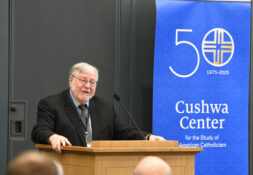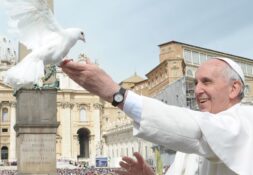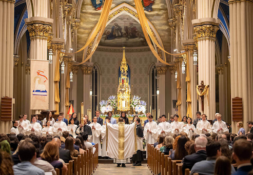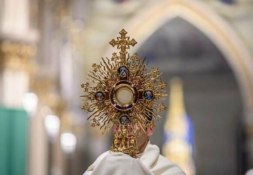Why singing worshipful Christmas music matters
While it is not yet Advent, Christmas music fills the air. There are many tunes about the jolly big-boned man, clad in red, who sneaks into homes unsolicited; though, rather than stealing the hard-earned possessions within a home, he gives presents to nice children. Aside from the songs regarding the imposed arbitrary present-donning system put in place, songs also mention the babe lying in the manger. This dichotomy of music raises the question — which Christmas carols are most appropriate for the season?
The Church has a long tradition of Scripturally-grounded song as a core tenet of worship. As detailed in the Rule of St. Benedict, the Desert Fathers were purported to pray the entire psalter in a day, and early monastic communities prayed every psalm in a week’s time. One Biblical basis of liturgical song can be found in Isaiah 6:3, the origin of the Sanctus which is said by the congregation at every Mass: “And they cried to one another, and said: Holy, holy, holy, the Lord God of hosts, all the earth is full of his glory.” It is from Luke’s account that the Gloria originates: “And suddenly there was with the angel a multitude of the heavenly army, praising God, and saying: Glory to God in the highest; and on earth peace to people of good will,” (Luke 2:13-14). When the Church sings in worship, we join the chorus of the angels and saints in Heaven.
Carols are not written for the direct purpose of worship, even if some carols were based on hymns such as Veni redemptor gentium (fourth century) or Corde natus ex parentis (fifth century). The word carol etymologically derives from the French “carole,” meaning “ring dance.” They were common songs for laity to celebrate most Church holy days. Carols sung in the vernacular may have developed in the thirteenth century, when St. Francis of Assisi incorporated vernacular songs in his nativity plays. However, carols often originated as drinking songs, such as “The Boar’s Head Carol.” Macaronic, or bilingual, carols were sung in Latin and the vernacular in the fourteenth and fifteenth centuries, similar to “Angels We Have Heard on High.”
Most of the carols sung in the Medieval period fell out of use during the Renaissance. However, carols became more popular in the mid-nineteenth century, and with the advent of neo-Medieval movements in the Victorian era, carols were revived as a uniquely English genre. As with their medieval counterparts, these new carols grew out of both sacred and secular sources. Therefore, a distinction should be made based on those origins: “Good Christian Men Rejoice,” for example, is derived from the fourteenth century vernacular and Latin carol “In Dulci Jubilo,” making it significantly more appropriate for sacred use than, for example, the former Welsh drinking song “Deck the Halls.”
More than a carol’s origins, however, it is important to consider the content of what is sung. Some, such as “Hark the Herald Angels Sing” or “O Come All Ye Faithful,” are beautiful reflections on the events of the Nativity which inspire greater devotion and love for God in those who hear them. Most secular carols, on the other hand, are exuberant but ultimately lack deeper theological meaning. Some, such as “We Wish You a Merry Christmas,” for example, at least make passing reference to the “good tidings” of the season, but many other modern Christmas carols are simply whimsical tales involving red-nosed reindeer and talking snowmen.
Listening to sacred music outside liturgical contexts does not take away the sacredness of religious music. Rather, it encourages us to live our lives liturgically, to come to a deeper appreciation of the carols which theologically and catechetical speak to the core of the Christmas season. Likewise, it is not inherently negative for songs about Rudolph and Frosty to merely reflect the general positive spirit present in the secular sphere around Christmastime, but we should be able to distinguish a merely cheerful song from one which reflects the sacred mystery of the season, that is, sacred music.
Sacred music is a Christo-Pneumatological ascent of the mind being spiritually raised to God the Father through the grace of the Son and the Spirit. It is a song of love between the persons of the Holy Trinity: the Logos, the Word Who is Christ, is sustained by the ruah, the Breath that is the Holy Spirit. The Word and The Breath create a song of love to the Father: music is a trinitarian dialogue. This eternal song of love sung to the Father is the pre-existing reality that is in Heaven, so when we partake in singing for the glory of God, we too participate in this heavenly hymn. Sacred Christmas music, like all sacred music, should be rightly ordered to this song.
This article was brought to you by the Theology Club’s Zossima Project: Making prayer an education. For a complete works cited, please email zossimaprojectnd@gmail.com. Thank you for your readership.






Leave a Reply